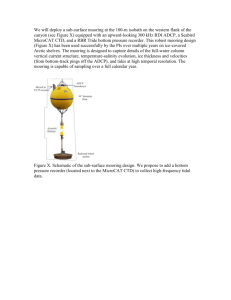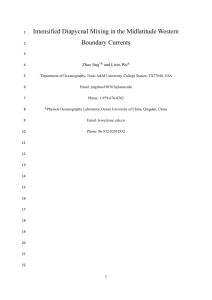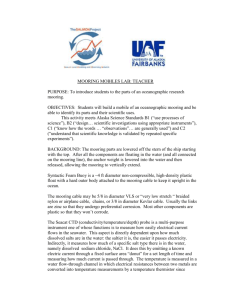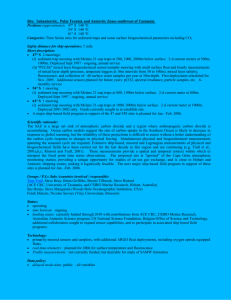This paper not to be cited without prior referenee to... ICES C.M. 1996/S:34 Theme Session S
advertisement
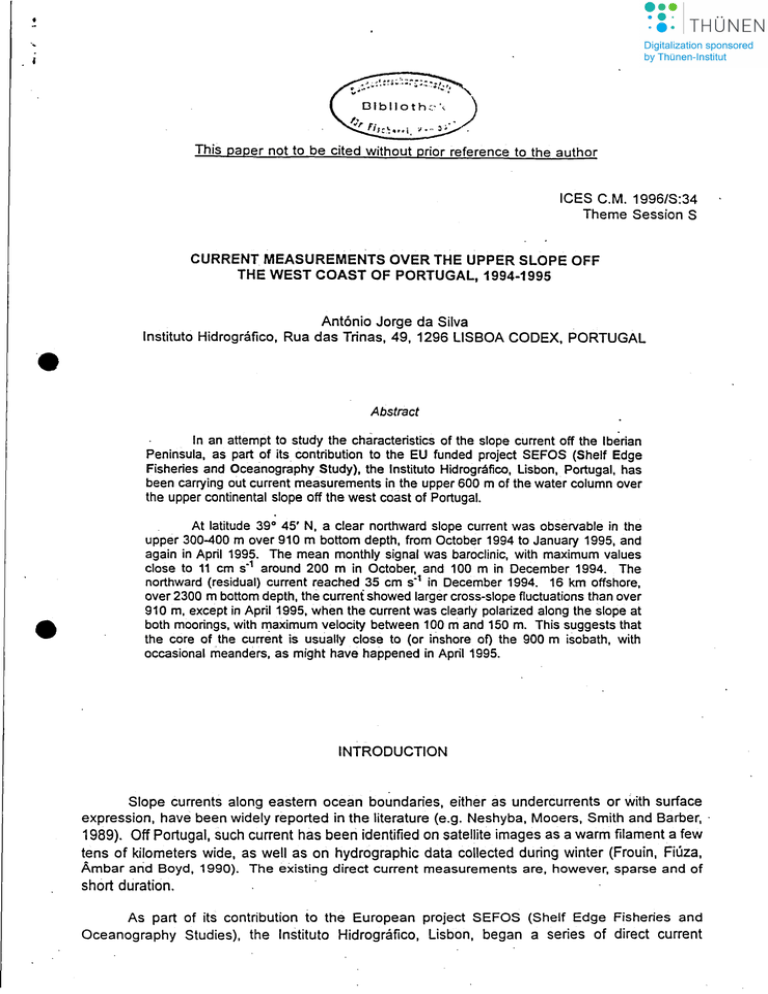
This paper not to be cited without prior referenee to the author ICES C.M. 1996/S:34 Theme Session S CURRENT. MEASUREMENTS OVER THE UPPER SLOPE OFF THE WEST COAST OF PORTUGAL, 1994-1995 •• Antonio Jorge da Silva Instituto Hidrografieo, Rua das Trinas, 49, 1296 lISBOA CODEX. PORTUGAL Abstract In an attempt to study the eharaeteristies of the slope eurrent off the Iberian Peninsula, as part of its contribution to the EU funded projeet SEFOS (Shelf Edge Fisheries and Oeeanography Study), the Instituto Hidrografico, Lisbon, Portugal. has been earrying out eurrent measurements in the upper 600 m of the water eolumn over the upper eontinental slope off the west eoast of Portugal. At latitude 39° 45' N, a elear northward slope eurrent was observable in the upper 300-400 m over 910 m bottom depth, from Oetober 1994 to January 1995, and again in April 1995. The mean monthly signal was baroelinie, with maximum values close to 11 cm s·1 around 200 m in Oetober, and 100 m in December 1994. The northward (residual) current reached 35 em 5.1 in December 1994. 16 km offshore, over 2300 m bottom depth, the eurrent showed larger cross-slope fluctuations than over 910 m, exeept in April 1995. when the current was c1early polarized along the slope at both moorings. with maximum veloeity between 100 m and 150 m. This suggests that the core of the current is usually dose to (ar inshore of) the 900 m isobath, with oecasional meanders, as might have happened in April 1995. INTRODUCTION Siope eurrents along eastem oeean boundaries, either as undercurrents or with surface expression, have been widely reported in the literature (e.g. Neshyba, Mooers, Smith and Barber, . 1989). Off Portugal, such current has been identified on satellite images as a warm filament a few tens of kilometers wide, as weil as on hydrographie data collected during winter (Frouin, Fiuza. Ämbar arid Boyd. 1990). The existing direct current measurements are, however, sparse and of short duration. As part of its eontribution to the European projeet SEFOS (Shelf Edge Fisheries and Oceanography Studies), the Instituto Hidrografico, Lisbon, began aseries of direct current measurements over the upper slope off the Portuguese west eoast. This is a short report on the eorresponding findings. This paper reports the results that were sueeessfully gathered from May 1994 to Oetober 1995 in three moorings: one at the latitude of SEFOS Standard Seetion 1 (37 0 45' N), over 491 m depth, and the other two at the latitude of Seetion 2 (39 0 45' N), over 910 m and 2300 m, eaeh one eonsisting of 4 Aanderaa eurrent meters at nominally 50, 100, 300 and 600 m (or 480 m). DATA AND METHODS In May-June 1994 two pairs of moorings were deployed along the Iines defined by the SEFOS Standard Seetions 1 and 2 (TurreI et al., 1995). Assistanee t6 the moorings was provided in November-Deeember 1994 and again in Oetober 1995. Due to aeeidents or malfunetions some of the series may have been signifieantly redueed as shown in the table below. The mooring loeations are indieated in Figure 1. Mooring 1A was never reeovered and therefore is not displayed in the figure. Mooring SEFOS Section Sottom depth Actual depth of the valid period of the (m) observations observations 50-100-190 LOST 59 104 21 Jun - 15 Sep 1994(a) 295 21 Jun - 15 Sep 1994 482 21 Jun - 09 Dec1994 145 10 May - 23 Nov 1994 1A 1 200 18 1 491 2A 2 I .. 910 . 21 Jun - 12 Jul 1994 195 16 Jun - 23 Nciv 1994 390 10 May - 23 Nov 1994 680 10 May - 23 Nov 1994 28 2 2300 50-100-300-600 LOST 2A 2 908 97 23 Nov 94 - 29 May 95 28 2 2300 145 23 Nov 94 - 29 May 95 342 23-26 Nov 1994 639 23 Nov 94 - 29 May 95 72-120-312-615 14 Dec 94 - 11 Oet 95 a) An interruption of ca. 24 hours occurred in the series on 16 July Aanderaa ReM 7, or ReM 4, have been used in all moorings, set for a sampling rate of 1 per hour. Following validation, the series have been submitted to a speetral analysis in order to find the best cutoff period to remove tidal and inertial frequencies. Residual currents were thus obtained by passing a seventh order Butterworth filter with a eutoff period of 35 hours. 2 • RESULTS AND DISCUSSION . Comparative statisties of the original and ihe filtered time series in all moorings provide indieation of the amount of vaiianee eontained in the low-frequeney domain. As ean be seeri from the table below,. the residual eurrent eontains a majo.r part of ttie varianee in the N-S eoniponent at the latitude of Seetion 2. The varianee of the E-W eomponent of tlle residual eurrent is rritieh smaller than that of the N-S eomponent in mooring 2A, but of similar magnitude in mooring 28, whieh may be assoeiated with different topographie steeiing (see Figure 1). It is, however, interesting that in the lowest level of mooring 2A, whiie the varianee level (not shown) is mueh smaller than above, the pereentage eontained in the low frequeney is similar in both eurrent eomponents. On the other hand, while the varianee of the E-W eurrent eomponent in moonng 28 has ci similar magnitude throughout the watl~r eolumn, its residual part looses importanee. In mooring 18 the varianee retained in the low frequeney is nearly the same in both .current eomponents, being quite smaller in the N-S eomponent than in the time series from the two northem moorings, whieh may be a result of a mueh srnaller topographie steering. .. . '''' "-"" \'''.'". .- '. .. ' .•... ...•,,<, .. ." :. '. ",' . ... varianee in the low frequencY domain (residual eurrent) as a percentage of the väriance in the original series .' Mooring 1A (Jun - Dee 1994) 2A (May - Nov 1994) e '0' 2A (Nov 94 - May 95) 28 (Dee 94 - Oet 95) Depth of observation (m) E·W component N-S eomponent 59 32.7 48.4 104 33.9 49.2 295 35.3 29.7 482 27.7 27.7 145 10.3 62.3 195 9.9 61.2 390 12.5 51.4 680 28.3 .27.5 97 24.6 64.4 145 21.9 72.0 (a) (a) (a) 639 21.0 30.8 61.2 72· 63.4 120 66.0 68.2 312 52.7 57.1 615 39.4 . 66.0, (a) The series is only 4 days long Figure 2 shows eurrent speetra of the original. unfiltered series obtained in the upper eurrent meters in moorings 2A and 28 in .1995, showing a detail of their low-frequeney domain. Obvious peaks of variability eorresporid, as expected, to the semi-diurnal tide and the inertial frequeney. A tidal harmonie is also identifiable, although with a mueh lower energy level. The energy level in the 3 -------------~---- - low frequency domain is quite significant and some energetic bands are observable: that around 5 days in mooring 28 is quite prominent, and present throughout the water column. Also to be noticed the higher energy in N-S component in' mooring 2A and the reverse situation in mooring 28. In most of the spectra obtained with blocks of 1024 hours the second spectral estimate (21.3 days) appeared quite prominent. When the analysis was made with half the fundamental frequency the peak was centered either around the same period or around 42.6 days. Although it was not possible to obtain a goöd statistical significance at such periods given the length of the series. one was led to look tor basic periods around 1 month to perform another statistical analysis. The actual time intervals for the statistics have been chosen in such a way that, whenever possible. they would not contain any major currerit reversals in the upper three series of mooring 2A. The results of such statistic calculations are presented in Figures 3-7. When analyzing Figures 3-7 it is necessary to bare in. mind that the surface layer understood as the upper 50-100 m, - was never covered by the measurements. In mooring 18, almost 40 km away from the coast, it is just possible to observe what might have beEm the onset of the upwelling by early July and its further development until September. A southward jet, or its outer border (5 cm S-1), appeared in the area and progressively extended downward, whilE:i eastward compensation current (2-5 cm S·1) could be seen down to about 300 m. No evidence was found of a northward undercurrent. • an Until mid-September 1994, the situation observed in mooring 2A (Figure 4) was not mucti different from that in mooring 18, except tor the negligible cross-slope component. In late September a northward current became evident, a situation that persisted until the end of January 1995 (Figure 5), with the tendency for the largest values to be found at shallower levels... In February, while the monthly mean longshore' current component was riegligible at mooring 2A, it became evident in Mooring 28 throughout the whole observed water column (Figure 6), which points to the possibility of a long periodic meander. In April 1995 the longshore current was similar . . in both moorings, in a suggestion that the current core might have been centered. in between them.· In May the situation observed the previous year at the same season was apparently resumed. agairi lasting the whole summer during which the motion was basically southward at mooring 28 (Figura 7). Throughout the observational period the mean monthly cross-slope component was negligible, except in January 1995, whe!n it was important and towards the coast in both moorings, particularly 28. At the deepest observational level, below 600 m. the monthly mean was usually very small at both moorings, pointing·to a very weak circulation at the distribution levels of the Mediterranean water. that was probably shifted offshore due to the effect of the submarine promentory south of Section 2 (Figure 1). In some disagreement with the generally accepted idea that the slope current is maximum in winter. the results of the investigations now being reported point to a maximum expression of the current in late autumn. which is quite evident in the progressive vector diagrams of the residual the ether hand, the usual absence of the current signal in one current presented in Figure 8. of the ;"oorings when it is present in the other (which is only 16 km apart) points to its filament On 4 nature. Finally, the recurrent presence of the slope current in autumn and winter at mooring 2A together with the proximity of the 200 m isobath, which roughly coincides with the shelf edge, provides reasons to suspect that the transport at the outer shelf may be non-negligible. REFERENCES • Frouin R, A.F.G. Fiuza, I. Ambar and T.J.Boyd (1990) Observations of a poleward surface current off the coasts of Portugal and Spain during winter. Journal of Geophysical Research, 95, 679-691. Neshyba S.J., C.N.K. Mooers, RL. Smith and RT. Barber (Eds.) (1989) Poleward f10ws along eastern ocean boundaries. Coastal and Estuarine Studies, 34, Springer-Verlag, New York, 374 pp. • 5 --9 -,", :...L2 . • \ ~4 ~ I '/~ --~ -39 ., i i i ~Ri ........1 ! Figure 1. Bathymetric chart of the W Iberian Peninsula and positions of the current meter moorings. Station positions tor SEFOS Standard Sections 1 and 2 are also reterenced. Isobaths correspond to 200 m, 1000 m, 2000 m, 3000 m, and 4000 m. • 10lXDl 10.lXDl SP l.I..B...t9llIS A·i1'", s.p M...S..IS1i!5 8-12'" 0ReIT"""""'" ~ 0ReIT"""""" ~ I.lXDl 1- 1 ]. <?:- ] j .1 1lXDl 1- <?:- Q.1<XX! ] 0.1CXX1 j 1 00100 0.0100 ... 00010 .lI) ... frequen:y (q:lI1) ... .'" 0.0010 • lI) ... ... ... .. .,. ." ... ... .. frequen:y (q:lI1) .·n_ u .....·...".. U ...... -1.....- ".17. 210.: . . . . . . . , . ..-...,..... itE-t 1f i o ~ " ;; te-3 .. ot U tJ frequency U (~) ~ ":. . .. aOlK. . . . . . ..~. .... -- ... .'" i'". ~ 1 ' 1E..z-: _e ~....",.. \ .... -- .... ~ " . ' ... ::l .. I .. i !~ i te-3 - . CL te.. . ot U OJ frequency 2.. 04 (~) " ., .10 ·5 0 5 ., v (c:mIS) v (c:mIs) v (c:mIs) .15 10 15 .10 20 0 5 ·15 ::~1)P ~ 4 0 5 ·5 0 5 '~)\I I' \\\ " ·10 .-$ 0 : / AUG· SEP 94 JUL-AUG 94 ·15 . \ U (_lI 10 0--+--"--;"""""> - _ ".00- u (_S) .10 200- 2" JUN· JUL 94 E .10 0 0 U S 10 o -t-'-.l-...-.L-.-+__'-----' o .15 -10 -5 (_lI 0 I 10 I 1~~!J 200~ ; I 1 .~'I . . '00- : / .: . ,/ JUN -JUL 94 JUL·AUG 94 AUG- SEP 94 Figure 3. Near monthly means, standard deviations and extremes of N-S (v - upper pannel) and E-W (u - (ower pannel) current components at mooring 1B, June - September 1994. ·10 ·S I 0 • v (Cm/.) v (Cm/.) v (emls) ·15 oI 5 I . I " 10 15 I. J ·15 200; \ ·5 ·20 -15 ·10 ·5 0 5 10 0' .-o.-L-...........L......._.L......._ _.>....-.L......-.J S 10 • r'L.-o.-J ·10 o 15 10 20 25 o+--~~..L.-.J.~j~j ·5 0 0- ......... v (eml.) 5 10 v (Cm/s) 15 ~.o...-...J_~ ·10 -5 o ..•.......l....-. 0 10 ." ~._ J~_ 15 ... _J. 20 25 30 200 200 I I 100 800·- I I ! 100 '00 200 I .I ! i -E 400'I ; : 1 \ ~O \ o t. -5 ·10 I o I I I u (Cm/I) u (Cm/I) u (Cm/I) u (eml') ·s oI I o , ., 0 SEp·ocr 94 AUG·SEP 94 JUL·AUG 94 JUN· JUL 94 MAY ·JUN 94 5 ·5 0- _.o._.L-..-. _..a......-I--..__ J 100 .00 100 100 0 ---l.-. ocr ·NOV 94 NOV·DEC 94 u (emls) u (Cm/.) , ·5 --,.-J~ 0 o+----'-~.-.· 5 .1 _.~_ 10 ... _L..._ ,I -10 ·5 o 0 ·5 ,1 ._.l,_.~ 10 .. II \ I I 800 ; ! I 200 / I I I I ~ li ~ 400-: I i 600 ! I IJ \ [ \ 200 200 200 400 E 400 S 400 t ß. t ! ! \ 200 - 200 400 ! 60D 600 600 100 100 .00 I I MAY ·JUN 94 JUN· JUL 94 JUL·AUG 94 JUL·AUG 94 SEp·ocr 94 ocr· NOV 94 3S __ ....L_..........i_~l-..__ I NOV·DEC 94 Figure 4. Near monthly means, standard deviations and extremes of N-S (v - upper pannel) and E-W (u - lower pannel) current components at mooring 2A, May - December 1994. Note the different scales of u and v. v (cmI') -20 ·15 ·10 0"; ·S 0 v (cmI.) S • 10 15 20 ·15 Q_ I ·10 .~_I ·5 __ .... 1 • 0 v (emt.) __ ... 10 15 -10 0- _.L~_.J 200 200 ; 200 , 400 ; I ! v (emt.) 10 15 20 ·15 o - .. 200 ·s I ß. • J • I. 15 J , 20 ·10 o . -I -5 _. _I 000 .00· 100- .00 FEB·MAR 95 MAR·APR 95 • (cmll) 0 ... 1__._ .. 5 J . . . J _1_ 10 4- ·'0 o __.. t.......o.-J -5 _, I .•. ! eoo U(cmll) 10 I I. 400 '00 JAN· FEB 95 • (cmt.) 5 ·'0 200 ß. eoo DEC 94 • JAN 95 01' 5 ..... _.....L-..o..-J_~_ I_ .. _J E 400 100 " -'0 0 •._ 3 I 600 -5 ~.1. -5 _"L_.~_._.J.~ APR·MAY 95 • (cmI.) 0 5 ·'0 o __ ~~ -5 I _J .~_1 • (eml') 0 .. _. ..L .• 5 10 o 1_-<. L ....... J. .• _, 0 •.• -s ,. S 0 .J I I I 200 1 I E ; Q. ! 400 200 j ! \ 200 200 200 400 [400 \ I : [ 400 g I ß. ß. I 600 I 600 i DEC 94 • JAN 95 ! 100 000 ... '00 JAN· FEB 95 ß. ~ '00 ... '00 , ß. ~ ! 1 g 400- FEB ·MAR 95 ( \I \ \ '00 MAR·APR 95 APR·MAY 95 Figure 5. Near monthly means, standard deviations and extremes of N-S (v - upper pannel) and E-W (u -Iower pannel) current components at mooring 2A, December 1994 - May 1995. Note the different scales of u and v. ·20 o 200 I i 400 ~ ! ; ! I 600 800 Y«mi') ·'0 I ..... ·S I S 0 I I __ I II "I I , I I .,. '0 ,. S \, \ I I 400 ·S 0 '0 ,. Y«mi.) ·S .l_.>__ J 600 t~ • I 20 ... 25 30 35 ~ 40 o _ L_~~J ~ I -15 ·'0 I,! '.§: 400 I I 600 600 800 600 800 MAR-APR 95 ·15 ·'0 ·5 0 10 15 o _l_-'.-..L. ...... _J '0 I ·10 -s APR-MAY 95 "(anis) " (aniS) _~..J....~ 0 10 ---,,__ L .......... J ·'0 f 400 :[ 0400· 5 i 0 S '0 .... _J. I 200 400- ·S O·_~l_.L..L._ 200 i 600j s ! 600 200 400 0 _1_ .-- .__. 400 " (aniS) i 1 ·s •• 1. -. 1i o 200 ·'0 0 ~ ·20 10'5 -.-._~_L~--.J 20 _J 200 FES- MAR 95 " (anis) 4 0 Y«mi.) 1S 400 JAN- FES 95 " (anis) 10 L .... ,~I '0 _1----'---- L .• 200 ! ! S ._~-l._.o.- 0- 5 a. 5a. 200 !i Y(anI.) ·10 200 DEC 94 - JAN 95 ·s '0 0 I o .,. Y«mI.) l~ i I 800 600 600 800 800 . 800 I I 800 ,i 000- I I DEC 94 • JAN 95 JAN· FES 95 FES.~ 95 MAR·APR 95 APR - MAY 95 Figure 6. Near monthly means, standard deviations and extremes of N-S (v - upper pannel) and E-W (u - lower pannel) current components at mooring 2B, December 1994 - May 1995 v (cm'S) ·10 ·S • I v (cmll) ~ 0 ,..... l.. .. _. 10 J I .• 15 ·15 o I ·10 _.I -5 1__ •__ 1 '15 .-'" o ·10 V(cm'I) 4 0 v (cm'I) 10 ·'0 .• .J......-J.~~-'--~.J O. 200 f ·5 ~ _1_ 0 ~_ 10 ~_....L._ •.. 1 200 400- ß. 3 600 000 I 100 I MAY -JUN 95 ·'0 0 .. .....L U(cmll) 0 .1._ • '0 ,. .,. o. f .00 .. .-J .• ..J._ ...... _ .,. _ ~-.J 0 .., AUG-SEP 95 .,. U(cmll) ·'0 I 0 0 - 200 f .00 f .00 400 S 3 600 600 . 600 ouo 0.. 000 000 JUN -JUL 95 ... J 5 600 MAY-JUN 95 .. U(cmll) ·'0 _ .... J_. _....J.--,--_ 200 5a. 3 ~ 100 U (cmll) ·'0 .A.-...J 5a. C- eoo - JUL-AUG 95 200 '00 f 600 JUN - JUL 95 .-._.1_._ ..1 .,,,-.' &c 100- JUL-AUG 95 AUG-SEP 95 Figure 7. Near monthly means, standard deviations and extremes of N-S (v - upper pannel) and E-W (u - lower pannel) current components at mooring 28, May - September 1995. 150 125 100 300 ß I :.. I Mooring 2A 24 Oct· 22 Noy 1994 - 2~~OY8~~4 Dec 1994 145m .... !'~ ... (. ( j • I \ cu ~ 75 E '" ,1I '~ 300m 6BOm ,. 200 "u :~n j" '0'" ". ..(" " ,,\,, ) E [ .,..: Ju 250 - 195m Z <Il "] Mooring2A • 75 -, Moonng 2A 25 Jan· 24 Feb 1995 ,.5m '+ 87m • 6Jlitm o - 138m ,.5m --_._-------- , :.~ .. .. ' 25 I . '5 50 25 0 I /\ .t.. J" C .", ~:....( J' , ••••• o 100 " .ljI.',J"·} 50 •. !..o .... i .. , u ::~, 0" ··'i'·:· 0 25 -, I o ~O I () u 25 kmlowards E I" " ,, -50 :~ :: "t,.... ~_u u .. ....Jll 2[;, -._" I 50 75 -75 ,'- ,-- --,_.._. ,_.__r---.u, o I ·50 100 I o -25 kmlowards E "-'''''''---,----r--,-, ·25 t.,," ... ' ,,' u t :~;j I 0' ." : / \ ""1f\.K'I~" .,..•" ~ .....Io. " -25 ,';' " rs ~--r_---y-- 25 50 ... I 7S kmlowardsE Figure 8. Mooring 2A - progressive vector diagrams for selected periods in late autumn and winter 1994-95 I 25
